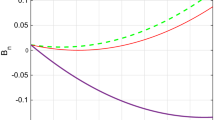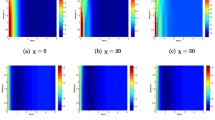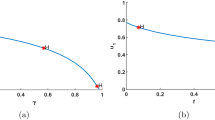Abstract
In this paper, we propose a predator–prey model with prey refuge and fear effect under non-diffusion and diffusion. For the non-diffusion ODE model, we first analyze the existence and stability of equilibria. Then, the existence of transcritical bifurcation, Hopf bifurcation and limit cycle is discussed, respectively. We find that when the cost of minimum fear \(\eta \) is taken as the bifurcation parameter, it not only influence the occurrence of Hopf bifurcation but also alters its direction. For diffusion predator–prey model under homogeneous Neumann boundary conditions, we observe that the Turing instability does not occur, but the Hopf bifurcation will manifest near the interior equilibrium. By considering \(\eta \) as the bifurcation parameter, the direction and stability of spatially homogeneous periodic orbits are established. At last, the validity of the theoretical analysis are verified by a series of numerical simulations. The results indicate that prey refuge and fear effect play an key role in the stability of populations.









Similar content being viewed by others
Data Availability
All data generated or analysed during this study are included in this published article.
References
Ritchie, E.G., Johnson, C.N.: Predator interactions, mesopredator release and biodiversity conservation. Ecol. Lett. 12(9), 982–998 (2009)
Holling, C.S.: The functional response of invertebrate predators to prey density. Mem. Entomol. Soc. Can. 98, 5–86 (1966)
Beddington, J.R.: Mutual interference between parasites or predators and its effect on searching efficiency. J. Anim. Ecol. 44, 331–340 (1975)
DeAngelis, D.L., Goldstein, R.A., Oneill, R.V.: A model for tropic interaction. Ecology 56, 881–892 (1975)
Abrams, P.A., Ginzburg, L.R.: The nature of predation: prey dependent, ratio dependent or neither? Trends Ecol. Evol. 15(8), 337–341 (2000)
Ivlev, V.S.: Experimental ecology of the feeding of fishes, University Microfilms, (1961)
Hassell, M.P., Varley, G.C.: New inductive population model for insect parasites and its bearing on biological control. Nature 223, 1133–1137 (1969)
Hu, D., Li, Y., Liu, M., Bai, Y.: Stability and Hopf bifurcation for a delayed predator-prey model with stage structure for prey and Ivlev-type functional response. Nonlinear Dynam. 99, 3323–3350 (2020)
Hu, D., Cao, H.: Stability and bifurcation analysis in a predator-prey system with Michaelis–Menten type predator harvesting. Nonlinear Anal-Real. 33, 58–82 (2017)
Hu, D., Cao, H.: Bifurcation and chaos in a discrete-time predator-prey system of Holling and Leslie type. Commun. Nonlinear Sci. 22(1–3), 702–715 (2015)
Hu, D., Yu, X., Zheng, Z., Zhang, C., Liu, M.: Multiple bifurcations in a discrete bazykin predator-prey model with predator intraspecific interactions and ratio-dependent functional response. Qual. Theor. Dyn. Syst. 22(3), 99 (2023)
Zhang, W., Zhao, S., Meng, X., Zhang, T.: Evolutionary analysis of adaptive dynamics model under variation of noise environment. Appl. Math. Model. 84, 222–239 (2020)
Xiang, C., Huang, J., Ruan, S., Xiao, D.: Bifurcation analysis in a host-generalist parasitoid model with Holling II functional response. J. Differ. Equations 268(8), 4618–4662 (2020)
Qi, H., Meng, X.: Threshold behavior of a stochastic predatorCprey system with prey refuge and fear effect. Appl. Math. Lett. 113, 106846 (2021)
Qi, H., Meng, X., Hayat, T., Hobiny, A.: Stationary distribution of a stochastic predator-prey model with hunting cooperation. Appl. Math. Lett. 124, 107662 (2022)
Liu, Q., Jiang, D.: Influence of the fear factor on the dynamics of a stochastic predator-prey model. Appl. Math. Lett. 112, 106756 (2021)
Zhang, H., Cai, Y., Fu, S., Wang, W.: Impact of the fear effect in a prey-predator model incorporating a prey refuge. Appl. Math. Comput. 356, 328–337 (2019)
McNair, J.N.: Stability effects of prey refuges with entry-exit dynamics. J. Theor. Biol. 125, 449–464 (1987)
Kar, T.K.: Stability analysis of a prey-predator model incorporating a prey refuge. Commun. Nonlinear Sci. Numer. Simulat. 10, 681–691 (2005)
Chen, L., Chen, F., Chen, L.: Qualitative analysis of a predator-prey model with Holling type II functional response incorporating a constant prey refuge. Nonlinear Anal-Real. 11(1), 246–252 (2010)
Ma, Z., Wang, S., Li, W., Li, Z.: The effect of prey refuge in a patchy predator-prey system. Math. Biosci. 243(1), 126–130 (2013)
Zhou, Y., Sun, W., Song, Y., Zheng, Z., Lu, J., Chen, S.: Hopf bifurcation analysis of a predator-prey model with Holling-II type functional response and a prey refuge. Nonlinear Dynam. 97(2), 1439–1450 (2019)
Chang, X., Wei, J.: Stability and Hopf bifurcation in a diffusive predator-prey system incorporating a prey refuge. Math. Biosci. Eng. 10(4), 979–996 (2013)
Altendorf, K.B., Laundré, J.W., González, C.A.L., Brown, J.S.: Assessing effects of predation risk on foraging behavior of mule deer. J. Mammal. 82(2), 430–439 (2001)
Laundré, J.W., Hernández, L., Altendorf, K.B.: Wolves, elk, and bison: reestablishing the landscape of fear in yellowstone National Park, USA. Can. J. Zool. 79(8), 1401–1409 (2001)
Creel, S., Christianson, D., Liley, S., Winnie, J.A.: Predation risk affects reproductive physiology and demography of elk. Science 315, 960–960 (2007)
Zanette, L.Y., White, A.F., Allen, M.C., Clinchy, M.: Perceived predation risk reduces the number of offspring songbirds produce per year. Science 334(6061), 1398–1401 (2011)
Cresswell, W.: Predation in bird populations. J. Ornithol. 152(1), 251–263 (2011)
Wang, X., Zanette, L., Zou, X.: Modelling the fear effect in predator-prey interactions. J. Math. Biol. 73, 1179–1204 (2016)
Wang, X., Zou, X.: Modeling the fear effect in predator-prey interactions with adaptive avoidance of predators. Bull. Math. Biol. 79(6), 1325–1359 (2017)
Sarkara, K., Khajanchi, S.: Impact of fear effect on the growth of prey in a predator-prey interaction model. Ecol. Complex. 42, 100826 (2020)
Sasmal, S.K., Takeuchi, Y.: Dynamics of a predator-prey system with fear and group defense. J. Math. Anal. Appl. 481(11), 123471 (2020)
Roy, J., Alam, S.: Fear factor in a prey-predator system in deterministic and stochastic environment. Physica A. 541, 123359 (2020)
Ko, W., Ryu, K.: Qualitative analysis of a predator-prey model with Holling type II functional response incorporating a prey refuge. J. Differ. Equations 231(2), 534–550 (2006)
Peng, R., Shi, J.: Non-existence of non-constant positive steady states of two Holling type-II predator-prey systems: strong interaction case. J. Differ. Equations 247, 866–886 (2009)
Li, C., Wang, X., Shao, Y.: Steady states of a predator-prey model with prey-taxis. Nonlinear Anal. 97, 155–168 (2014)
Qiao, T., Cai, Y., Fu, S., Wang, W.: Stability and hopf bifurcation in a predator-prey model with the cost of anti-predator behaviors. Int. J. Bifurcat. Chaos 29(13), 1950185 (2019)
Song, Y., Jiang, H., Yuan, Y.: Turing-Hopf bifurcation in the reaction-diffusion system with delay and application to a diffusive predator-prey model. J. Appl. Anal. Comput. 9(3), 1132–1164 (2019)
Upadhyay, R.K., Roy, P., Datta, J.: Complex dynamics of ecological systems under nonlinear harvesting: Hopf bifurcation and turing instability. Nonlinear Dynam. 79, 2251–2270 (2015)
Tiwari, V., Tripathi, J.P., Mishra, S., Upadhyay, R.K.: Modeling the fear effect and stability of non-equilibrium patterns in mutually interfering predator-prey systems. Appl. Math. Comput. 371, 124948 (2020)
Song, D., Li, C., Song, Y.: Stability and cross-diffusion-driven instability in a diffusive predator-prey system with hunting cooperation functional response. Nonlinear Anal-Real. 54, 103106 (2020)
Li, Q., Liu, Z., Yuan, S.: Cross-diffusion induced Turing instability for a competition model with saturation effec. Appl. Math. Comput. 347, 64–77 (2019)
Yan, S., Jia, D., Zhang, T., Yuan, S.: Pattern dynamics in a diffusive predator-prey model with hunting cooperations. Chaos Soliton. Fract. 130, 109428 (2020)
Song, Y., Tang, X.: Stability, steady-state bifurcations, and turing patterns in a predator-prey model with herd behavior and prey-taxis. Stud. Appl. Math. 139(3), 371–404 (2017)
Yang, R., Jin, D., Wang, W.: A diffusive predator-prey model with generalist predator and time delay. AIMS Math. 7(3), 4574–4591 (2022)
Duan, D., Niu, B., Wei, J.: Hopf-Hopf bifurcation and chaotic attractors in a delayed diffusive predator-prey model with fear effect, Chaos. Soliton. Fract. 123, 206–216 (2019)
Qi, H., Meng, X., Hayat, T., Hobiny, A.: Bifurcation dynamics of a reaction-diffusion predator-prey model with fear effect in a predator-poisoned environment. Math. Method. Appl. Sci. 45(10), 6217–6254 (2022)
Lou, Y., Ni, W.: Diffusion, self-diffusion and cross-diffusion. J. Differ. Equations 131, 79–131 (1996)
Yang, R., Nie, C., Jin, D.: Spatiotemporal dynamics induced by nonlocal competition in a diffusive predator-prey system with habitat complexity. Nonlinear Dynam. 110, 879–900 (2022)
Yang, R., Wang, F., Jin, D.: Spatially inhomogeneous bifurcating periodic solutions induced by nonlocal competition in a predator-prey system with additional food. Math. Method. Appl. Sci. 45(16), 9967–9978 (2022)
Sotomayor, J.: Generic bifurcation of dynamical system. Dynam Syst (1973). https://doi.org/10.1016/B978-0-12-550350-1.50047-3
Meiss JD.: Differential Dynamical Systems. Society for Industrial and Applied Mathematics, Philadelphia (2007)
Wiggins, S., Golubitsky, M.: Introduction to applied nonlinear dynamical systems and chaos, vol. 2. Springer, Berlin (1990)
Hassard, B.D., Kazarinoff, N.D., Wan, Y.: Theory and applications of Hopf Bifurcation. Cambridge University Press, Cambridge (1981)
Garvie, M.R.: Finite-difference schemes for reaction-diffusion equations modeling predator-prey interactions in MATLAB. Bull. Math. Biol. 69(3), 931–956 (2007)
Burton, T.A.: Volterra integral and differential equations. Academic Press, Inc., Orlando (1983)
Acknowledgements
This work was supported by the Doctor Research Project Foundation of Liaoning Province of China (No. 2023-BS-210).
Author information
Authors and Affiliations
Contributions
HZ and HQ wrote the main manuscript text. HQ prepared all figures. All authors reviewed the manuscript.
Corresponding author
Ethics declarations
Conflicts of interest
The authors declare that they have no conflict of interest.
Additional information
Publisher's Note
Springer Nature remains neutral with regard to jurisdictional claims in published maps and institutional affiliations.
Appendices
Appendix A
Proof of Theorem 2.1
From model (2), denote
It is obvious that we have two boundary equilibrium points
where \(E_0\) is always existed in model (2), \(E_1\) is existed when \(R_0>1\).
For the positive equilibrium point \(E^*=(u^*,v^*)\): if conditions \(\mathbf {C.0}\) hold, \(u^*=\frac{\mu _2}{(\theta \beta -a\mu _2)(1-\delta )}\) exists and \(v^*\) is the positive root of following equation
where \(B_1= {\mu _2\theta \gamma }/{(\theta \beta -a\mu _2)^2(1-\delta )^2}+{\theta (\mu _1-r\eta )}/{(\theta \beta -a\mu _2)(1-\delta )}+\alpha \), \(B_2={\alpha \theta [\mu _2\gamma -(r-\mu _1)(\theta \beta -a\mu _2)(1-\delta )]}/{(\theta \beta -a\mu _2)^2(1-\delta )^2}\).
For \(B_2<0\), that is \(\delta ^{*}> \delta \ge 0\), the above equation has a unique positive root given by
\(\square \)
Proof of Theorem 2.2
(I) For equilibrium \(E_0\): The corresponding Jacobian matrix of the model (2) is
which has two eigenvalues \(\lambda _1=r-\mu _1\), \(\lambda _2=-\mu _2<0\). If \(R_0<1\), then the equilibrium \(E_0\) of model (2) is locally asymptotically stable node point. But if \(R_0>1\), \(E_0\) is a saddle.
(II) For equilibrium \(E_1\): The corresponding Jacobian matrix of the model (2) is
Obviously, we have two eigenvalues \(\lambda _1=-r+\mu _1\), \(\lambda _2={\theta \beta (1-\delta ) u_1}/{1+a(1-\delta )u_1}-\mu _2\). Noting that \(\lambda _1<0\) is equivalent to \(R_0>1\) and \(\lambda _2<0\) is equivalent to
When \(R_1<1\), that is \(\beta \theta <a\mu _2\), which means that the right side of the inequality (A.2) is less than zero. Then we obtain \(\lambda _2<0\). When \(R_1>1\), that is \(\beta \theta >a\mu _2\), we obtain \(1>\delta >\delta ^{*}\) by calculating the inequality (A.2). Thus, we obtain conditions for locally asymptotically stability of \(E_1\), i.e., \(R_1<1\) or \(R_1>1\) and \(1>\delta >\delta ^{*}\).
(III) For positive equilibrium \(E^*=(u^*,v^*)\): The corresponding Jacobian matrix of model (2) is
We can obtain the following characteristic equation
where
From (A.5), we have \(\textrm{det}(J_{E^*})>0\) always hold. And we know that \(\textrm{tr}(J_{E^*})<0\) is equivalent to
When conditions \(\mathbf {C.0}\) and \(\delta ^{*}> \delta \ge \delta ^{**}\) are satisfied, the left side of the inequality (A.6) is less than zero, then we obtain \(\textrm{tr}(J_{E^*})<0\). If the condition \(\delta ^{**}> \delta \ge 0\) are satisfied, by calculating the inequality (A.6), we obtain \(\eta ^*>\eta \ge 0\) which can make \(\textrm{tr}(J_{E^*})<0\). Then we know that the positive equilibrium \(E^*\) is a locally asymptotically stable node for \(\textrm{tr}^2(J_{E^*})>4\textrm{det}(J_{E^*})\) and stable focus for \(\textrm{tr}^2(J_{E^*})<4\textrm{det}(J_{E^*})\).
Now, we consider the global asymptotic stability of the positive equilibrium point \(E^*\) under conditions \(\mathbf {C.0}\) and \(\delta ^{*}> \delta \ge \delta ^{**}\) of Theorem 2.2.
Denote a Dulac function \(B(u,v)=(\alpha +v)(1+a(1-\delta )u)u^{-1}v^b\), where b is to be specified later, then
where
When \(1-\frac{\theta \beta -a\mu _2}{ar}\ge \eta \ge 0\) holds, we have
for \(u\in {\mathbb {R}}_+\).
Thus, we need to prove \(h_2(u,b)\le 0\) for all \(u\in {\mathbb {R}}_+\) such that \(D\le 0\) for all \((u,v)\in {\mathbb {R}}_+^2\).
Since \(a\alpha \gamma (1-\delta )>0\) always holds, then we can obtain that
such that \(D\le 0\) for all \((u,v)\in {\mathbb {R}}_+^2\), where
That means that there is a \(b+1\) such that
which is equivalent to
This simplifies to \(\delta >\delta ^{**}\).
Thus, there exists b such that \(D\le 0\) for all \((u,v)\in {\mathbb {R}}_+^2\). By the Bendixson-Dulac theorem [56], we obtain that \(E^*\) is globally asymptotically stable under both conditions \(\mathbf {C.0}\), \(\delta ^{*}> \delta \ge \delta ^{**}\) and \(1-{\theta \beta -a\mu _2}/{ar}>\eta \ge 0\). \(\square \)
Appendix B
Proof of Theorem 2.7
Let \(\widehat{u}=u-u^*\) and \(\widehat{v}=v-v^*\), then we can rewrite the model (2) by the Taylar expansions as follows (for simplicity, u and v represent \(\widehat{u}\) and \(\widehat{v}\) again, respectively)
The model (B.1) can be rewritten as
where
with
We know that the characteristic roots of \(J_{E^*}\) are
When \({-a_{12}a_{21}>S^2}\), the eigenvalues \(\lambda _1\) and \(\lambda _2\) will be complex conjugate, especially, when \(\eta =\eta ^*\), \(\lambda _1\) and \(\lambda _2\) will be purely imaginary, that is, \(S(\eta ^*)=0\) and \(\lambda _{1,2}=\pm i T(\eta ^*)\).
The eigenvectors of \(J_{E^*}\) corresponding to the eigenvalues of \(\lambda _{1,2}=S + i T\) are given by
where Y and Z are defined in (5).
Let the matrix
By using the transformation
then, the model (B.2) becomes
where
The model (B.4) can be written in the polar form as
The Taylors series expansion of (B.5) at \(\eta =\eta ^*\) gives
where \(m(\eta ^*)\) is defined in (4).
Owing to
Therefore, we have \(\Lambda =-\frac{m(\eta ^*)}{S'(\eta ^*)}\), which determines the stability of Hopf bifurcating periodic solution. \(\square \)
Rights and permissions
Springer Nature or its licensor (e.g. a society or other partner) holds exclusive rights to this article under a publishing agreement with the author(s) or other rightsholder(s); author self-archiving of the accepted manuscript version of this article is solely governed by the terms of such publishing agreement and applicable law.
About this article
Cite this article
Zhang, H., Qi, H. Hopf Bifurcation Analysis of a Predator–Prey Model with Prey Refuge and Fear Effect Under Non-diffusion and Diffusion. Qual. Theory Dyn. Syst. 22, 135 (2023). https://doi.org/10.1007/s12346-023-00837-5
Received:
Accepted:
Published:
DOI: https://doi.org/10.1007/s12346-023-00837-5




